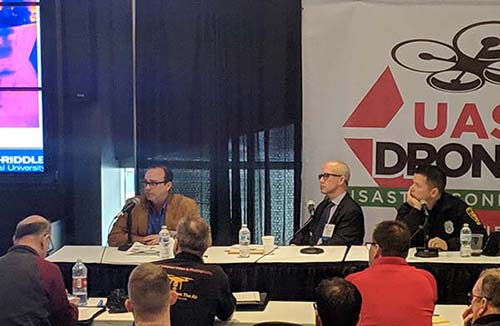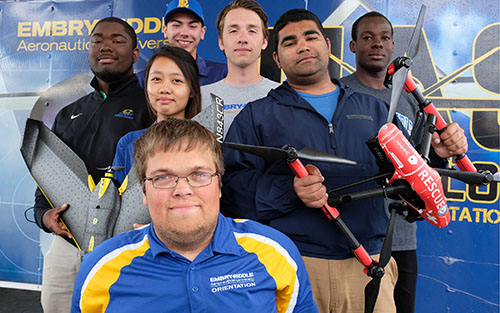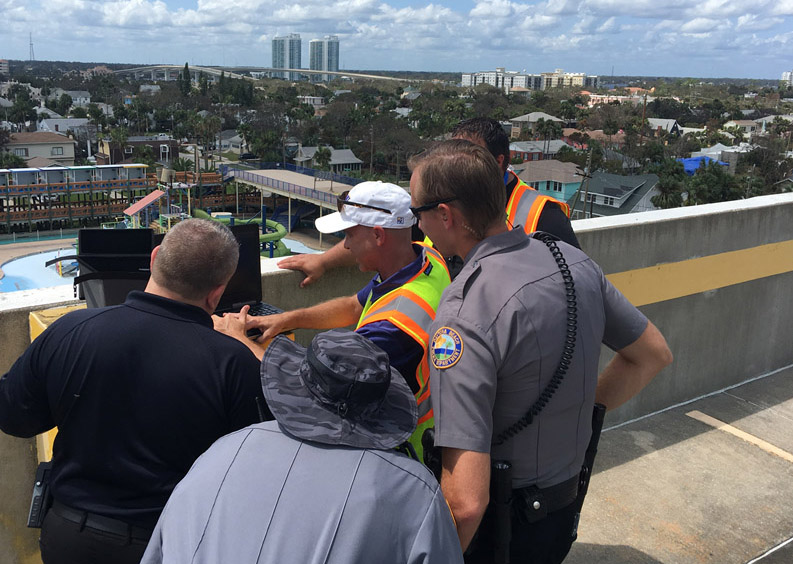At the recent UAS DRONES Disaster Conference, public safety officials from across the country gathered together to discuss where and how drone technology has been able to make a difference for fire departments, police officials and in emergency response situations. While numerous departments have been able to have success with the technology, challenges with doing so are less and less about the technology itself. Instead, issues related to data integration and especially proper training and certification are delaying the adoption of the technology.

Dr. Cerreta presents the benefits of the TOP program to Public Safety officials at the UAS DRONES Disaster Conference.
In order to speak to the challenges related to drone training and certification, Dr. Joseph Cerreta from Embry-Riddle Aeronautical University (ERAU) spoke to the audience to detail how the
Trusted Operator Program (TOP) was created to maximize safety, reliability and professionalism in the commercial use of drones. While the program creates a standard way to demonstrate proficiency, it is ultimately designed to do much more by enabling consensus-based industry standards that will undoubtedly have a positive influence on the entire UAS industry and flight safety as a whole.
Dr. Cerreta is an Assistant Professor in the Department of Flight at ERAU, and has
previously talked about how ERAU leveraged existing UAS core curriculum to meet the learning objectives necessary for TOP certification. He explored some of these details during his UAS Drones Disaster Conference session, but we wanted to learn more about where and how the TOP program is making a difference. We connected with him to talk about AUVSI’s involvement with the program, the six functional areas in the TOP program, what people need to know if they’re just getting started with the program and much more.
Jeremiah Karpowicz: Can you talk a little bit about the genesis of the Trusted Operator Program? When and how was the need for this type of program identified?Dr. Joseph Cerreta: Currently to fly a commercial drone in the US, a remote pilot is only required to demonstrate knowledge on a FAA knowledge test. There is no proficiency or skills-based test. The test does not examine the remote pilot’s ability to safely fly an aircraft. The Trusted Operator Program (TOP) closes that gap by requiring both knowledge in many core areas, such as aeronautical knowledge, risk management, and crew resource management as well as a Practical Flight Assessment (PFA) for the upper two levels of the program (there are three levels in the TOP program). The PFA is a performance assessment to determine if the remote pilot seeking this certification has the skills and proficiency required by the TOP protocols to safety fly the aircraft.
In what way is the TOP program distinct or different from ERAU’s many other professional education programs?Embry-Riddle recognizes the need for education that goes beyond the traditional academic setting. Especially in industries that change rapidly, professionals want to be able to get cutting edge training in short courses covering topics of particular interest. That’s why we have professional education course on topics like aviation cybersecurity and small UAS fundamentals for public safety. With these courses, we have been able to leverage our extensive experience in online education to provide top quality instruction and engagement to our non-degree seeking students.
Our TOP training brings a new dimension to our UAS professional education in two ways: first, in addition to their great education, students will earn an independent, third party certification that will validate their knowledge skills and abilities, and that will demonstrate to employers and companies their professionalism and dedication; second, because TOP Levels 2 and 3 involve a practical flying portion, students will practice and hone their flying skills with Embry-Riddle instructors. This is a great opportunity that none of our professional programs have been able to offer before.
The TOP program is a competency-based program designed by members from the industry, who focused on closing gaps from existing professional programs. TOP was designed as a consensus of protocols by subject matter experts, which leverage a credible reference hierarchy. This approach is not a standards approach, but a protocols approach, in which a protocol is defined as a specified level of knowledge, ability, performance, or compliance with a regulation, industry standard, association standard, or best practice. So the TOP program leverages the most applicable existing standards. Also, the TOP program can provide individual certifications for remote pilots and remote pilot instructors as well as organizational level certifications for UAS service providers, training organizations, and public safety agencies.

the ERAU team is preparing a flight just after completing their TOP Level 3 certification with a DJI Inspire 2 in Prescott, AZ. Depicted from left to right: Assistant Professor Stefan Kleinke reading the anemometer; Assistant Professor David Thirtyacre serving as a TOP Level 3 Remote Pilot Instructor; Associate Professor Dr. Scott Burgess serving as the TOP Level 3 Remote Pilot In Command; and Assistant Professor Dr. Kristy Kiernan serving as the Visual Observer holding an electronic aircraft checklist. (Photo taken by Joseph Cerreta)
A few years ago, AUVSI conducted a listening tour, visiting with Remote Pilot’s Council members around the country. In the process of meeting with remote pilots, AUVSI realized the need for an independent certification program that would allow individuals, service providers, and training organizations to demonstrate the skills knowledge and abilities that are the hallmarks of safe, efficient, effective operations. Without some kind of certification, how could employers, users of drone services, or students know what they were buying? Working with the Remote Pilots Council and partners in industry and academia, AUVSI developed TOP to meet that need.
What are some of the distinctions between being certified as a TOP Operator in the United States versus Canada? Does that certification transfer from one country to another? Because the TOP program uses a protocols approach, the credible reference hierarchy enables modularity in the program. At the top of the hierarchy are regulations. For US-based TOP certifications, the protocols require compliance with the US Federal Aviation Regulations (FARs). For TOP operators in Canada, it is Transport Canada’s Canadian Aviation Regulations (CARs).
Can you briefly explain the differences between Level 1 through Level 3 of your certificates?The TOP program has three levels of certifications. Each of the levels are organized with sets of protocols aligned to the risk and complexity of operations typical at each level. TOP Level 1 is focused on lower risk levels in which routine operations do not require a regulatory waiver, typically using electric aircraft less than 5 pounds, and away from populated areas.
Level 2 would be applicable when a UAS operation requires a waiver to a regulation. Level 2 would also be appropriate when the operations use a visual observer or sensor operator and operations have elevated risk factors such as operations near airports or populated areas.
Level 3 is for operations in safety-critical and complex areas that require higher levels of risk mitigation. Level 3 operations may occur in hazardous or extreme environments or require the development and testing of new procedures. Also, Level 3 operations would occur with UAS over 55 pounds.
What sort of gaps with flying knowledge and skills have you seen Part 107 operators struggle with? Are those struggles something they don’t always recognize?One really helpful aspect of this program is that it helps operators realize what they don’t know, and fill in those gaps. The RPC test covers a lot of important material, but what about how to use a spectrum analyzer, or how to systematically analyze and mitigate risk? Those are issues that remote pilots might not encounter every day. It’s not that pilots don’t care about those things, they just may not have had a way to acquire that knowledge.
Also, some Part 107 certificated operators may have never flown a UAS before because it is not required of the Remote Pilot Certificate. In Part 61 for manned aviation certification (i.e., Sport, Private, Commercial Pilot, etc.) there are aeronautical experience requirements established by a minimum number of flight hours. For example, a Private Pilot must have 40 hours of flight time, 20 hours with an instructor and 10 hours as a solo pilot. Part 107 does not require any aeronautical experience. That potentially puts risk on the end user hiring a remote pilot who may have an inadequate level of experience to safely plan and execute a mission.
Some operators and even organizations view Part 107 certification as the end of the road, but that’s not a great way to think about what it means to maintain and improve operational safely of UAS in the NAS, is it? A Part 107 certificate is the ground floor for commercial UAS operations in the US. Operators and organizations are looking for ways to stand out from their competitors. Certificate programs, such as TOP, are a way to stand out. The TOP protocols require operators and organizations to develop processes and procedures to consistently and safely operate UAS. As UAS become integrated into the National Airspace System, processes and procedures will become key components to their effectiveness.
And honestly, TOP doesn’t just impact operational safety, it affects risk management in all areas. Public acceptance of drone operations will really be influenced by how safe and professional our operations are. Individuals and companies can show their commitment to safe responsible flying by participating in the TOP program – that’s some pretty positive advertising.
Section 3 outlines distinct functional areas of operation, including UAS operations in agriculture, UAS operation in Public Safety and plenty more. Would you say it’s harder or easier to operate or become certified in one of these industries over another?There are six functional areas in the TOP program, including agriculture, environmental services, infrastructure and utility inspections, petroleum oil and gas inspections, public safety operations, and as training providers. Each set of protocols for these functional areas were designed by experts in these segments. Each of these functional areas have different aspects and uses for UAS, hence they are organized into separate functional areas.
The certification process for each functional area is the same, whereas the remote pilot or organization must demonstrate competency to the protocols for each of them. The goal of the functional areas is to establish very specific competencies to perform safe UAS operations in the context of each. For example, the public safety functional area requires the completion of FEMA’s National Incident Management Systems (NIMS) courses, compliance with NFPA 2400, and Embry-Riddle evaluates remote pilot’s proficiency using the principles from the National Institute of Standards and Technology (NIST) guide to measuring and comparing sUAS capabilities and remote pilot proficiencies using standard test methods.

ERAU students participate with the Oklahoma Department of Emergency Management during a UAS operations immersion program to provide tornado response support. ERAU Worldwide UAS students are now TOP Level 3 eligible as a part of the UAS operations concentration. Depicted from left to right: Michael Morgan, Judy Dun, Andrew Bieniek, Max Dunphy, Andrew Hardy, Rohit Gohil, and K’Andrew France-Beckford. (Photo taken by Joseph Cerreta)
End users and customers who receive the data from remote pilots or service providers are beginning to realize that hiring a UAS operator could put their business at risk. To mitigate that risk, customers are beginning to require certifications like TOP. Just recently, we had a UAS service provider ask us to provide training to their entire organization within the next three weeks. We later understood their customer, electric utility company, required TOP Level 2 certification for anyone inspecting their lines. Additionally, remote pilots who are looking for work and want to stand out from their competition are beginning to realize the TOP program offers an external certification recognizes competency and reflects highly on their level of professionalism.
In what way is the TOP part of industry events like the Commercial UAV Expo? Is that an ideal place to begin or complete training? Embry-Riddle can deliver the certification courses for the knowledge components of TOP in the classroom, including at world-renown events like the Commercial UAV Expo, or via online modalities. The Practical Flight Assessment is an in-person evaluation of the remote pilot’s abilities to demonstrate safety, proficiency, and competency in UAS operations. Embry-Riddle plans these assessments at various locations and times during the year, including major events such as during the Commercial UAV Expo.
Many people may find it convenient to earn their TOP Level 1 certification in person at an event like Commercial UAV Expo, and then continue their upper level training throughout the year in the online modality, and finally complete the practical fight assessment at a convenient time and place.
If I’m an individual operator with their Part 107 certificate, what’s one thing you’d want me to know about the Trusted Operator Program?Your Part 107 certificate enables you to operate a UAS for hire. The TOP program enables you communicate to your organizational stakeholders and customers that you have demonstrated a level of competency to safely operate a UAS for hire.
Along those same lines, if I’m an organizational stakeholder that wants to explore drone adoption for my company, what’s one thing about the Trusted Operator Program that I need to convey to others in my organization? The TOP program is designed to improve UAS operational safety of remote pilots and organizations. The protocols require organizations to establish and maintain safety risk management processes, which can mitigate the liability risk to a UAS organization. These processes could also lead to process improvement that would ultimately improve the organization’s bottom line by increasing efficiency, consistency, and customer satisfaction. That’s what it did for our own flight department.
What’s my best first step if I think the Trusted Operator Program might be a fit for me, but I’m not sure where to begin? Embry-Riddle offers many aviation safety and UAS related professional education courses. Anyone interested in the TOP program can find information from AUVSI’s website at
https://www.auvsi.org/topoperator. Also, from Embry-Riddle’s professional education programs, including many aviation safety courses, which may be found at
https://proed.erau.edu/.



















Comments